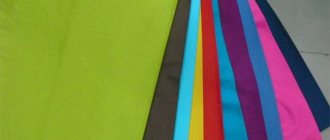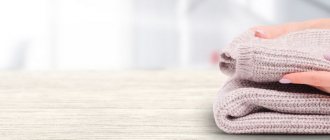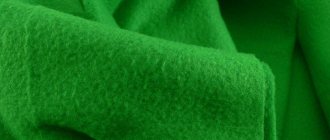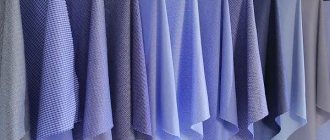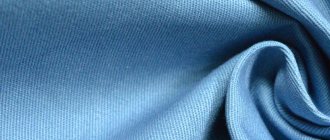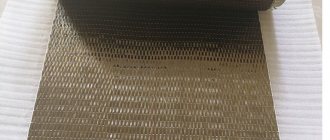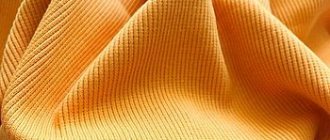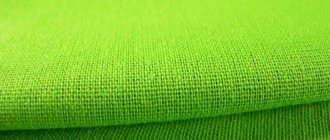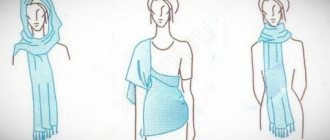History of fabric
On the English island of Jersey, blown from all sides by cold, piercing winds, a breed of sheep with warm, soft wool has long been raised. Wool was used to produce fabric from which warm work clothes for fishermen and underwear were made. The fabric was named after the island - jersey.
In the 19th century, clothing manufacturers tried to adapt knitwear to make tracksuits. The idea failed, the suits were not sold out, the factories that produced them went bankrupt and closed.
Jersey fabric gained its popularity at the beginning of the 20th century, thanks to the world famous Coco Chanel. The fashion designer presented a jersey coat in her collection. The reaction of society ladies was negative, a huge scandal broke out, and the show was a failure. Ladies considered it indecent to wear clothes made from lingerie fabric. But Coco Chanel did not give up, and at the next show beautiful dresses made of jersey jersey were released. The sophistication of the taste of the famous designer did their job, the fabric was accepted by the public.
Description and composition
With the development of the weaving industry and technology, the composition of the material changed, and with it the characteristics. Initially, the main raw material was sheep wool , but over time, canvases from other materials appeared:
- cotton
- silk
- linen
- synthetics
Silk jersey type is the most expensive. Various combinations of raw materials and the addition of synthetic (polyester) and artificial (bamboo, viscose) materials are also used.
Composition and types of fabric
At the beginning of its history, jersey was made from sheep's wool. Nowadays knitwear is made from wool, cotton, silk, synthetic threads, and their combinations.
Depending on the raw materials used, fabrics are divided into main groups:
- natural - made from threads of natural origin (classic wool, cotton, linen, silk);
- artificial - from viscose, bamboo;
- synthetic - from lycra, polyester, elastane.
The combination of different types of threads in one fabric allows you to combine the properties of all components in it, achieving the required qualities and properties.
Fabric composition options
There are a variety of jersey fabrics available for sale. The description of the properties of the material primarily depends on the raw materials used.
| Types of fibers | raw materials | Title (examples) |
| Natural | vegetable, animal. | cotton, linen, wool, silk. |
| Artificial | natural (cellulose) | viscose, acetate, lyocell (Tensel) |
| Synthetic | petroleum derivatives | lavsan, nylon, spandex, lycra, polyester |
Made from natural fibers
To make natural fabric, cotton and wool fibers are more often used, and silk and linen are less often used. Other options are exotic and rare on sale.
Knitwear made of lightweight, breathable cotton is indispensable for T-shirts, pajamas, and children's clothing. The appearance of microholes on fabric does not depend on the weaving, but on the quality, including density, of the cotton thread.
Woolen knitwear comes in thin and thick fabrics. Depending on the fur of the animal, the fabric may be more or less fluffy. Range of use: from underwear to outerwear.
Premium-class knitwear is considered to be silk fabric - thin, drapes amazingly, and is not see-through. Elegant dresses, tops, and underwear are made from it.
The unique qualities of linen jersey create an eco-style: undyed or minimally dyed, breathable, reducing body temperature in hot weather by 3-4 degrees compared to cotton.
Made from artificial fibers
Man-made fibers are made by humans from natural raw materials that do not have fibers, such as tree cellulose. Such fibers are called artificial from a production point of view, but have the properties of natural ones.
The characteristics of the resulting fibers vary depending on the technical process.
Common:
- viscose;
- acetate;
- lyocell (Tensel).
It is possible to make jersey entirely from artificial fibers. This fabric is hygroscopic, breathable, and does not accumulate static electricity. As a rule, this is a thin knitwear that is perfect for underwear, blouses, dresses and turtlenecks.
Made from synthetic fibers
Synthetic fibers are made from polymeric materials that do not occur in nature. During oil refining, fiber-forming substances are obtained, from which synthetic threads are subsequently created. The structure of the substance determines the properties of the fibers.
Common:
- lavsan;
- nylon;
- spandex;
- lycra;
- polyester.
The composition of knitwear can consist of 100% synthetic fibers. At the same time, they differ in appearance, for example, fleece, artificial suede, microfiber, velor. Fabrics made from these fibers are wear-resistant, easily dyed, and inexpensive. Fine fabrics are used to make linen, hosiery and clothing. Thick fabric is used for upholstering furniture, sewing bags, awnings, and covers.
Blended fabrics
Blended fabrics have become the most popular, as they combine the best qualities. Options for combining all types of fibers are possible: natural, artificial and synthetic.
Combining wool or cotton with elastane or lycra gives the fabric additional elasticity and shine. Replacing natural fibers with man-made fibers in this blend will reduce the cost of the fabric and increase strength without losing body comfort properties. The combination of natural and artificial fibers in the manufacture of knitwear fully guarantees the quality of natural raw materials, reducing costs and increasing wear resistance.
The percentage of fibers in the fabric varies.
Advice. When choosing a fabric, you need to consider whether the item sewn from it will directly touch the body. For example, a pure wool dress may tingle. It is better to choose a mixed fabric.
Jersey properties, advantages and disadvantages
The properties of a fabric primarily depend on the fibers it contains.
Jersey has many advantages .
- Elasticity, the ability to stretch. The canvas stretches across the width of the fabric, not lengthwise.
- Wrinkle-resistant, easy to care for. The material does not require constant ironing; clothes made from it are easily stored on shelves in the closet; even with this storage method, folds and creases do not form.
- Softness. The fabric is pleasant to the touch, suitable even for sewing clothes for babies who have delicate and sensitive skin.
- Thermal conductivity. Clothing made from jersey wool fibers will prevent you from freezing during the cold season and allows you to regulate heat transfer.
- Hygroscopicity. The fabric absorbs and retains moisture. Synthetic jersey does not have this property; it is not advisable to wear clothes made from it in the heat.
- Breathability. The material breathes and allows air to pass through.
- Eco-friendly, hypoallergenic. This only applies to natural jersey. It does not cause skin irritation and is safe.
- Lightness, weightlessness. The fabric does not restrict movement, its weight is almost not felt when worn.
- Wear resistance. The material can withstand a large number of washes, after long-term use it does not fade, does not become shiny, does not rub, or stretches.
- The fabric lays in soft rounded folds and does not form creases.
The disadvantages include the peculiarities of jersey.
- The fabric hugs your figure. If the silhouette is not perfect, all imperfections will be visible.
- The surface of the jersey may develop pilling over time.
- The material becomes electrified and sticks to the body. This is uncomfortable and unaesthetic. To a greater extent, this disadvantage is inherent in synthetic jersey. To reduce electrification, you can use special aerosol products, they help a lot.
Jersey fabric cost
The cost of jersey depends on the manufacturer’s pricing policy and composition. The average prices for a meter of fabric are as follows:
- with a predominance of viscose - 400–500 rubles;
- a mixture of viscose and nylon – 700–900 rubles;
- on a wool base - 1000–1100 rubles;
- polyester – 400–600 rub.
There are more expensive types of material. Fabrics containing alpaca wool and silk are considered elite. They are very expensive and require especially careful care and storage separately from other things.
An overview of the difference between expensive and cheap materials:
Application area
Jersey fabric is versatile. Great for sewing clothes for every day. Depending on the composition of the fibers, the material is used to sew:
- underwear - made of thin jersey (silk, viscose);
- jackets and coats - made of thick jersey (wool);
- evening dresses are attractive in silk jersey;
- casual dresses, office and travel suits, T-shirts, trousers - from all types of jersey;
- children's clothing - mainly made of cotton jersey;
- home clothes, dressing gowns, pajamas;
- pantyhose stockings.
Photo
Jersey fabric photo 1
Jersey bedding
Jersey knit fabric
Jersey fabric photo 3
Jersey fabric photo 2
Jersey knit dresses
Care instructions
The fabric is not fancy, the rules of care are simple.
- Be sure to study the product label, which indicates the composition and basic care instructions. Observe them strictly. Only in this case will the item last a long time.
- Suitable for both hand washing and machine washing in an automatic machine, with water at a temperature of up to 40 degrees, to avoid deformation and loss of shape of the product.
Deformation without restoring its original shape is possible if care recommendations are not followed: when washing a woolen item in hot water, it will certainly shrink.
- The use of neutral powders and fabric softeners is allowed.
- You can spin it in the drum of a washing machine at a low speed.
- It is recommended to rinse in cool water, up to 20 degrees, to maintain color durability and brightness.
- It is better to dry naturally in a horizontal position, away from radiators and heaters. Before drying, straighten the product well.
- Iron through damp cotton cloth. Set the iron to the minimum temperature, if possible, to the steam mode. If available, you can use a household steamer.
- Store products in a well-ventilated area, avoiding exposure to sunlight.
A hot iron will damage the surface of the fabric, leaving shiny spots on it.
Care
In order for knitted items to retain their original appearance for as long as possible, it is very important to properly care for them. On finished items, manufacturers indicate the washing temperature, what products to use and at what temperature of the iron to iron the product; there may also be a label on a piece of fabric, but this is not always the case. Therefore, when purchasing material, check its composition.
Here are our tips for caring for jersey fabric.
- Hand or delicate machine wash required.
- It is not recommended to squeeze at high speeds, as this could cause the item to become deformed or even break. This especially applies to silk and viscose materials.
- It is better to squeeze the product lightly with your hands and let the rest of the water drain.
- Use liquid washing gels that do not contain chlorine, which can ruin the color and texture of the fabric.
- Dry the jersey flat on a clothesline.
- Iron with a not very hot iron. Silk and viscose items through gauze.
Based on the description of the jersey fabric, you are convinced that it is versatile and practical. It is made all over the world, painted in various colors and shades. She is very soft and practically unpretentious. So feel free to purchase items from it and enjoy wearing it.
Jersey products, how to choose and how to wear
- The original jersey is easy to recognize: when the fabric is stretched wide, it will easily stretch, and its edge will curl up.
- When purchasing jersey outfits, pay attention to the features of your figure. A straight, tight-fitting dress will suit those with a fragile, slender figure. Overweight women should choose models with elegant folds that hide imperfections and emphasize femininity.
- Choose the composition of the product according to the season. Wool jersey is popular in autumn and winter, and cotton jersey is popular in spring and summer. Don't buy synthetic jersey for the summer; in hot weather it's completely uncomfortable.
- Jersey clothing is simple and not overloaded with details; it can be combined with costume jewelry, jewelry and accessories. Depending on the situation, a silk scarf or woolen stole will complement the look well.
How fabric is made
Today's popular jersey fabric gets its name from its place of origin - the island of Jersey. Initially, at the beginning of the twentieth century, it was made by hand from sheep's wool, and the material protected it very well from wind and cold.
Today, jersey material is knitted on machines, yes, it is knitted, not woven, using a wide variety of raw materials. It turns out to be a single-row weave of threads. On the front side, the braid pattern is clearly visible; on the back side, the so-called “brickwork” pattern is visible; this relief resembles the one obtained by hand knitting.
The most popular question about this fabric is: does jersey stretch or not? The material stretches well in width thanks to this knitting, but does not stretch at all in length. The photo of the jersey clearly shows its texture.
The photo clearly shows the texture of the jersey fabric
Customer Reviews
Customers often leave positive reviews of jersey products. The durability of the products and the versatility of the fabric are most often noted. Owners of jersey clothes are satisfied, the items wear well, fit well, people emphasize that they do not need to be ironed, they are warm, light, and comfortable in all respects. The few who did not follow the fabric care standards were disappointed ; their clothes became stretched and deformed, becoming unsuitable for wear.
Jersey has won customer recognition due to its high quality and unique properties. This practical and durable fabric is happily used by designers all over the world for sewing clothes; every home is sure to have items made from it.
Clothes care
The first question that customers usually ask is: how to wash jersey? This can be done either manually or using an automatic machine. Experts recommend setting the temperature to no more than 20 degrees. This will preserve the brightness of the color of the fabric for a long time. When spinning, you should select a program with minimum speed.
Clothes are dried in the fresh air without the use of special equipment. Before hanging a textile item to dry, straighten it well to avoid wrinkles.
What else do you need to know when caring for jersey clothing? Iron such textiles using hot steam. It is recommended to first cover the outfit with a thin cloth or gauze.
A steam bath will help rid clothes of the musty smell that can form due to infrequent use. To do this, hold the hanger with the item over hot water. The steam from it will refresh your clothes in 5-10 minutes.
Video: what is jersey
An interesting video about where jersey fabric came from, why women love it and why everyone who sews clothes appreciates it.
See similar articles
- Chintz is a lightweight cotton fabric for summer clothes.
- Crepe chiffon is a translucent fabric with a grainy surface.
- Supplex - elastic fabric for sports and swimwear
- Natural silk - the fabric is smooth, durable and elegant
- Denim is a versatile, thick cotton denim fabric
- Fabric for making a coronavirus mask with your own hands
If you liked the article, share it with your friends!
What are jerseys and where did they come from?
A jersey is, first of all, a jersey made from a player's football uniform, made of silk or synthetic fiber. The history of the jersey began in Britain in the 80s, when the working class made football the main game on the planet. That’s when football aesthetics began to penetrate into the everyday wardrobe of first fans, and then all city residents. They eagerly bought Ralf Lauren and Burberry polos, Stone Island jackets and vintage adidas sneakers. This process is now being carried out with sports jerseys, which will eventually become a wardrobe staple. Palace was one of the first skate brands to make the jersey part of its casual collection in 2012. Then this fashion was picked up by KITH, adidas and Gosha Rubchinsky.
Type and description of material
Jersey is a knitted fabric that is used primarily for clothing. Originally made from wool, now other natural and artificial fibers are used in production.
Jersey fabric colors
When making jersey, single-row weaving is used. Single knitting produces a light and elastic knitted fabric, one side of which is smooth and the other with a pile. There is also double knitting (interlock jersey), which is less elastic. The fabric consists of two fabrics, knitted so that the smooth sides are external, and the pile is in the middle.
Thanks to the single-row weaving method, a pattern formed by rows of vertical loops resembling braids is visible on the front side of the material. Horizontal stripes are visible on the inside.
A characteristic feature of jersey: the fabric stretches well across, but does not stretch. And if you stretch the raw edge of the canvas, it will immediately curl into a tube.
Nowadays, jersey material is produced on special knitting machines. The world's largest supplier of this type of knitwear is China. Other major producers include Turkey, Korea, Italy, France, Switzerland and Portugal.
